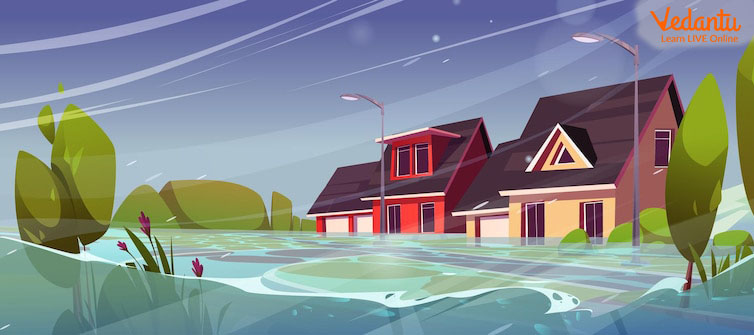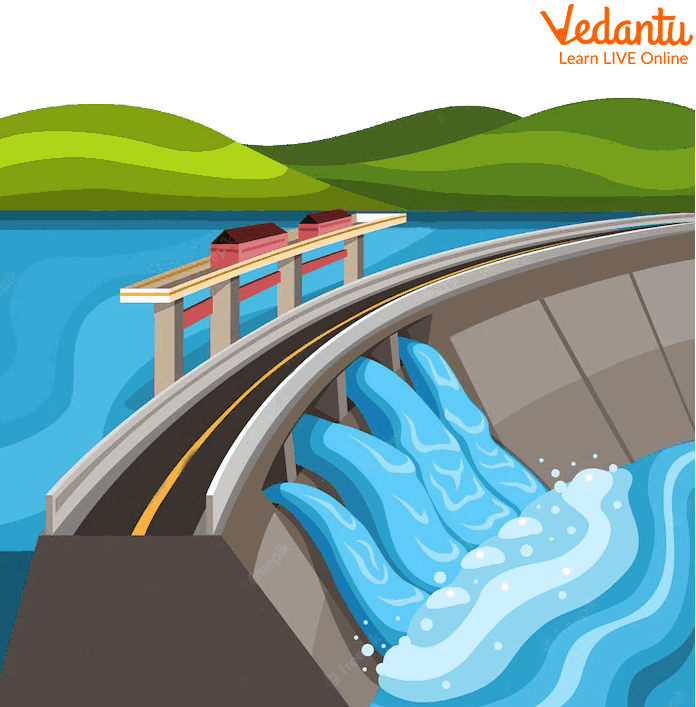




What is a Flood?
A flood is generally defined as the overflow of large amounts of water on the earth's surface, causing destruction. Floods can occur due to many reasons like as a result of strong rains, incoming waves from the ocean, or the failure of dams or levees. Floods can happen suddenly or gradually over a long period and can last up to many days or weeks or even longer, depending upon the type and extent of the flood. Out of all the natural disasters, floods are the most common, seen all over the country at certain times.

The Flood Prevailed Everywhere in the Village and Drowned Everything.
What is Flooding?
Understanding floods is crucial when talking about them. So, we'll first try to understand the basic definition of flood.
A flood is when there is an excessive amount of water, and it usually covers dry areas. The science of hydrology includes studying floods. They may also start slowly and then pick up speed.
Causes of Flood
Flooding has a wide range of diverse causes. While different flood types often have various reasons, one of the following actions is responsible for most floods.
Heavy Rainfall- A lot of rain is the most specific cause of flooding. Sometimes, the water that falls on the earth's surface by rain doesn't get a proper place to be stabilised. This may cause flooding, including turbulent flash flooding.
Overflowing- The overflowing of many water bodies like big rivers and lakes can cause floods.
Damaged Dams Can Also Cause Broken Dams-Flooding. When there is a lot of rain, it's obvious that the water level will rise, resulting in older infrastructure collapsing. The aftermath of Hurricane Katrina's 2005 landfall in New Orleans included this.
Melting Snow and Ice- Another typical cause of floods is melting snow and ice. If a lot of snow melts quickly, it frequently has nowhere else to go but low-lying places.
What are the Effects of Flood?
Floods have a negative social, economic, and environmental impact on both persons and communities. Depending on the location and intensity of flooding, as well as the susceptibility and value of the natural and built environments they touch, the Effects Of Floods—both positive and negative—vary dramatically.
Floods can have various effects, including good and bad, depending on where they occur, how quickly they move, how vulnerable they impact nature and built infrastructure, and so on. Floods have adverse social, economic, and environmental effects on individuals and communities.
Methods of Flood Management
Some flood control techniques date back to ancient times. These techniques include building floodways, terracing hillsides to restrict flow downstream, and planting vegetation to hold surplus water (artificial channels to divert flood water).
Levees, lakes, dams, reservoirs, and retention ponds are other methods for storing extra water during floods. Some other techniques to manage floods are
Construction of Dams- Many dams and the reservoirs they are connected to have flood control and protection as one of their primary goals. In order to provide a specific amount of room for flood waters to fill, many large dams include flood-control reservations where the level of a reservoir must be kept below a particular elevation before the start of the rainy/summer melt season.
River Defences- Rivers are frequently carefully controlled because they are prone to flooding in many nations. Levees, reservoirs, and weirs are utilised as defences to stop rivers from overflowing their banks and prevent flooding.
Floodplains and Groundwater Replenishment- By redirecting extra water onto terrain that can soak it up, groundwater can be refilled. Through the use of the ground as a natural reservoir, this method can lessen the effects of future droughts.

A Dam Into Which Water Flow is Open at Full Speed.
Interesting Facts About Floods
Floods have occurred at some point in the history of mankind in most cultures and civilisations.
For practical reasons, ancient civilisations erected their monarchies next to rivers. River floods that harmed their lands and kingdoms were a problem they had to contend with over time.
Since ancient times, dams and levees have served as a flood defence system.
During the dry seasons, flood water is occasionally gathered for irrigation to irrigate crops.
Cities may be washed away by powerful floods that breach dams. They have the power to demolish bridges, highways, and other structures, uproot trees and bring about hurricanes.
Conclusion
Floods might be frightening, but it is up to us as individuals to ensure they don't interfere with our daily lives. Ponds, lakes, and other water reservoirs should all be kept in good condition. Flooding can be prevented by enhancing the soil's properties and making it easier for water to absorb.
FAQs on Flood - A Natural Disaster
1. How to be prepared for a flood?
You can do these things to be on the safer side to some extent:
Put your precious belongings in a safer place.
Be aware of where to turn off your gas or power.
Ensure your insurance covers property damage from flooding.
Have some sandbags, flood boards, or plastic coverings ready to block doorways and air bricks if your property is at risk of flooding.
2. What kills you in the flood?
The leading cause of flood deaths is drowning. These drownings mostly take place during flash floods. You can be swept off your feet by six inches of swiftly moving water. Use a pole or stick to check that the ground is firm below the surface if you pass through an area where water is standing.
3. How can I find out about my flood risk?
Building growth, alterations in weather patterns, wildfires, and other natural calamities that transform the topography can all affect how water drains and flows where you live. Because of this, the government continuously assesses threats and updates flood maps to reflect these changes.









